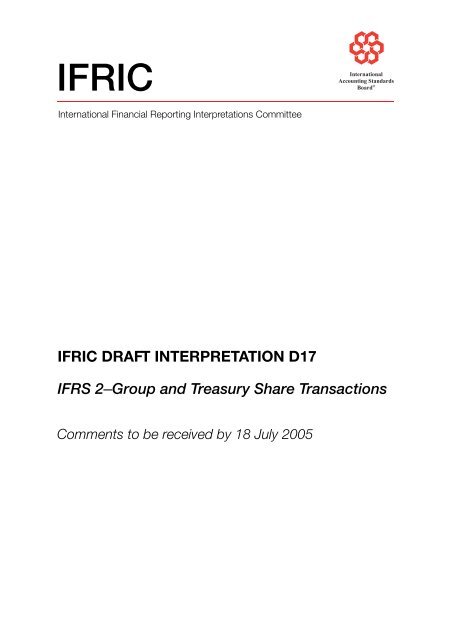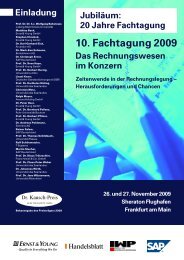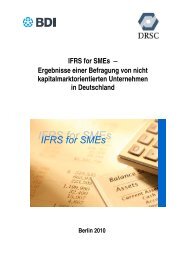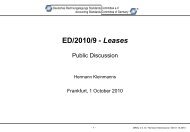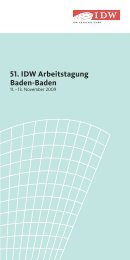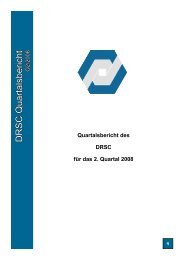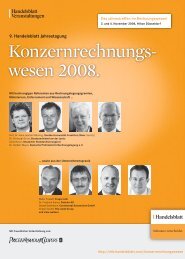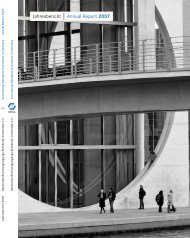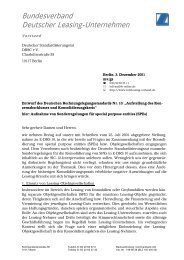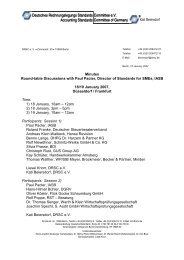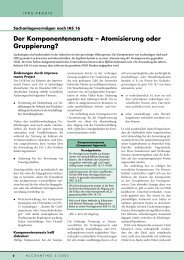IFRIC D17.fm
IFRIC D17.fm
IFRIC D17.fm
You also want an ePaper? Increase the reach of your titles
YUMPU automatically turns print PDFs into web optimized ePapers that Google loves.
<strong>IFRIC</strong><br />
International Financial Reporting Interpretations Committee<br />
<strong>IFRIC</strong> DRAFT INTERPRETATION D17<br />
IFRS 2–Group and Treasury Share Transactions<br />
Comments to be received by 18 July 2005<br />
International<br />
Accounting Standards<br />
Board ®
<strong>IFRIC</strong> Draft Interpretation D17 IFRS 2–Group and Treasury Share Transactions is<br />
published by the International Accounting Standards Board (IASB) for comment<br />
only. Comments on the draft Interpretation should be submitted in writing so as<br />
to be received by 18 July 2005.<br />
All responses will be put on the public record unless the respondent requests<br />
confidentiality. However, such requests will not normally be granted unless<br />
supported by good reason, such as commercial confidence. If commentators<br />
respond by fax or email, it would be helpful if they could also send a hard copy of<br />
their response by post. Comments should preferably be sent by email to:<br />
CommentLetters@iasb.org or addressed to:<br />
D17 Comment Letters<br />
International Accounting Standards Board<br />
30 Cannon Street, London EC4M 6XH, United Kingdom<br />
Fax: +44 (0)20 7246 6411<br />
The IASB, the International Accounting Standards Committee Foundation<br />
(IASCF), the authors and the publishers do not accept responsibility for loss<br />
caused to any person who acts or refrains from acting in reliance on the material<br />
in this publication, whether such loss is caused by negligence or otherwise.<br />
Copyright © 2005 IASCF ®<br />
All rights reserved. Copies of the draft Interpretation may be made for the<br />
purpose of preparing comments to be submitted to the IASB, provided such<br />
copies are for personal or intra-organisational use only and are not sold or<br />
disseminated and provided each copy acknowledges the IASCF’s copyright and<br />
sets out the IASB’s address in full. Otherwise, no part of this publication may be<br />
translated, reprinted or reproduced or utilised in any form either in whole or in part<br />
or by any electronic, mechanical or other means, now known or hereafter<br />
invented, including photocopying and recording, or in any information storage<br />
and retrieval system, without prior permission in writing from the IASCF.<br />
International<br />
Accounting Standards<br />
Board ®<br />
The IASB logo/‘Hexagon Device’, ‘eIFRS’, ‘IAS’, ‘IASB’, ‘IASC’, ‘IASCF’, ‘IASs’,<br />
‘<strong>IFRIC</strong>’, ‘IFRS’, ‘IFRSs’, ‘International Accounting Standards’, ‘International<br />
Financial Reporting Standards’ and ‘SIC’ are Trade Marks of the IASCF.<br />
This draft Interpretation is available from www.iasb.org
INVITATION TO COMMENT<br />
DRAFT INTERPRETATION MAY 2005<br />
The International Accounting Standards Board’s International Financial Reporting<br />
Interpretations Committee (<strong>IFRIC</strong>) invites comments on any aspect of this Draft<br />
Interpretation IFRS 2—Group and Treasury Share Transactions. It would<br />
particularly welcome comments on the question below. Comments are most<br />
helpful if they indicate the specific paragraph to which they relate, contain a clear<br />
rationale and, when applicable, provide a suggestion for alternative wording.<br />
Comments should be submitted in writing so as to be received no later than<br />
18 July 2005.<br />
Question<br />
Paragraph 9 of the draft Interpretation proposes that share-based payment<br />
transactions in which a parent entity grants rights to its equity instruments * direct<br />
to a subsidiary entity’s employees should be accounted for as equity-settled<br />
transactions. Paragraph 11 proposes that, for transactions in which a subsidiary<br />
entity grants to its employees rights to equity instruments of its parent, the<br />
subsidiary entity should account for those transactions as cash-settled<br />
transactions. Therefore, in the subsidiary’s individual financial statements, the<br />
accounting treatment of transactions in which a subsidiary’s employees are<br />
granted rights to equity instruments of its parent would differ, depending on<br />
whether the parent or the subsidiary granted those rights to the subsidiary’s<br />
employees. This is because the <strong>IFRIC</strong> concluded that, in the former situation, the<br />
subsidiary has not incurred a liability to transfer cash or other assets of the entity<br />
to its employees, whereas it has incurred such a liability in the latter situation<br />
(being a liability to transfer equity instruments of its parent). Do you agree with<br />
these proposals?<br />
* References in paragraphs 9-11 of the draft Interpretation to equity instruments of the parent<br />
entity also include equity instruments of another entity in the same group.<br />
3 © Copyright IASCF
<strong>IFRIC</strong> D17 IFRS 2–GROUP AND TREASURY SHARE TRANSACTIONS<br />
International<br />
Accounting Standards<br />
Board<br />
<strong>IFRIC</strong> International Financial Reporting Interpretations Committee<br />
®<br />
<strong>IFRIC</strong> DRAFT INTERPRETATION D17<br />
IFRS 2–Group and Treasury Share Transactions<br />
<strong>IFRIC</strong> [draft] Interpretation X IFRS 2–Group and Treasury Share Transactions<br />
([draft] <strong>IFRIC</strong> X) is set out in paragraphs 1-14 and the Appendix. [Draft] <strong>IFRIC</strong> X<br />
is accompanied by an Illustrative Example and a Basis for Conclusions. The<br />
scope and authority of Interpretations are set out in paragraphs 1 and 8-10 of<br />
the <strong>IFRIC</strong> Preface.<br />
© Copyright IASCF 4
References<br />
DRAFT INTERPRETATION MAY 2005<br />
IAS 8 Accounting Policies, Changes in Accounting Estimates and Errors<br />
IAS 32 Financial Instruments: Disclosure and Presentation<br />
IFRS 2 Share-based Payment<br />
Background<br />
1 Under IFRS 2, the accounting requirements for a particular share-based<br />
payment transaction depend upon whether the transaction is an<br />
equity-settled or cash-settled share-based payment transaction. For<br />
some share-based payment transactions involving treasury shares, or two<br />
or more entities within the same group of entities, there are questions<br />
about whether those transactions should be accounted for as<br />
equity-settled or cash-settled.<br />
2 An example of such transactions is when an entity grants share options to<br />
its employees, and either chooses or is required to buy back its own shares<br />
(ie treasury shares), to satisfy its obligations to its employees under the<br />
share-based payment arrangement. * Although the arrangement between<br />
the entity and its employees involves a grant of equity instruments of the<br />
entity, there is also a related transfer of cash to another party. This raises<br />
the question of whether the share-based payment transaction between the<br />
entity and its employees should be classified as equity-settled or<br />
cash-settled for the purposes of applying IFRS 2.<br />
3 Some share-based payment arrangements involve two or more entities<br />
within the same group of entities, such as a transfer of equity instruments<br />
of one entity to the employees of another entity within the same group.<br />
Although IFRS 2 applies to such transactions (IFRS 2, paragraph 3), it does<br />
not give guidance on how to account for these transactions in the<br />
individual or separate financial statements of each entity involved in the<br />
arrangement. For example, a subsidiary entity’s employees might be<br />
granted rights (vested or unvested) † to shares of its parent. Those rights<br />
might be granted by the subsidiary entity, or the parent entity might grant<br />
the rights direct to the subsidiary entity’s employees. The question is<br />
* Although this [draft] Interpretation focuses on share-based payment transactions with<br />
employees, it also applies to share-based payment transactions with parties other than<br />
employees.<br />
† In the remainder of this [draft] Interpretation, all references to rights granted to an entity’s<br />
employees include both vested rights and unvested rights.<br />
5 © Copyright IASCF
<strong>IFRIC</strong> D17 IFRS 2–GROUP AND TREASURY SHARE TRANSACTIONS<br />
whether the subsidiary entity should account for services received from its<br />
employees under such arrangements as cash-settled or equity-settled<br />
share-based payment transactions.<br />
4 This [draft] Interpretation focuses on the most common situations and<br />
does not address specifically the wide variety of share-based payment<br />
transactions involving groups of entities.<br />
Scope<br />
5 This [draft] Interpretation applies to share-based payment transactions<br />
within the scope of IFRS 2.<br />
Issues<br />
6 This [draft] Interpretation addresses share-based payment arrangements<br />
in which:<br />
(a) an entity grants to its employees rights to equity instruments of the<br />
entity, and either chooses or is required to buy those equity<br />
instruments (eg treasury shares) from another party, to satisfy its<br />
obligations to its employees under the share-based payment<br />
arrangement.<br />
(b) an entity’s employees are granted rights to equity instruments of the<br />
entity, either by the entity itself or by its shareholder, and the<br />
shareholder provides the equity instruments needed to settle the<br />
share-based payment arrangement.<br />
(c) a subsidiary entity’s employees are granted rights to equity<br />
instruments of the parent entity (or another entity in the same group),<br />
in particular, arrangements in which:<br />
(i) the parent entity grants those rights direct to the subsidiary<br />
entity’s employees, and<br />
(ii) the subsidiary entity grants those rights to its employees.<br />
Consensus<br />
7 The entity shall account for a share-based payment transaction as<br />
cash-settled if it has a liability to transfer cash or other assets of the entity<br />
to its employees under the share-based payment arrangement between<br />
the entity and its employees. An entity’s own equity instruments<br />
© Copyright IASCF 6
DRAFT INTERPRETATION MAY 2005<br />
(eg treasury shares) are not assets of the entity, whereas the equity<br />
instruments of another entity (eg shares of its parent) are assets of the<br />
entity.<br />
8 Share-based payment transactions in which an entity receives services<br />
from its employees as consideration for equity instruments of the entity<br />
shall be accounted for as equity-settled transactions. This applies<br />
irrespective of whether the entity chooses or is required to buy those equity<br />
instruments from another party, to satisfy its obligations to its employees<br />
under the share-based payment arrangement. This also applies<br />
irrespective of whether:<br />
(a) the employee’s rights to the entity’s equity instruments were granted<br />
by the entity itself or by its shareholder(s); or<br />
(b) the share-based payment arrangement was settled by the entity<br />
itself or by its shareholder(s).<br />
9 Share-based payment transactions in which a parent entity grants rights to<br />
its equity instruments * direct to a subsidiary entity’s employees shall be<br />
accounted for as equity-settled transactions. This applies to the separate<br />
or individual financial statements of the parent entity and the subsidiary<br />
entity and also to the group’s consolidated financial statements.<br />
10 Some share-based payment arrangements involve a parent entity granting<br />
rights to its equity instruments to the employees of more than one<br />
subsidiary. In some cases, an employee of one subsidiary might transfer<br />
employment to another subsidiary during the vesting period, without the<br />
transfer affecting the employee’s rights under the share-based payment<br />
arrangement. The subsidiary entity to which the employee transfers<br />
employment shall measure the fair value of the services received from the<br />
employee by reference to the fair value of the equity instruments at the date<br />
those equity instruments were originally granted to the employee by the<br />
parent entity.<br />
11 If a subsidiary entity grants to its employees rights to equity instruments of<br />
its parent, the subsidiary entity shall account for the share-based payment<br />
transaction with its employees as cash-settled. In this situation, the<br />
subsidiary entity has incurred a liability to transfer assets of the entity (the<br />
equity instruments of the parent entity) to its employees. This applies<br />
irrespective of whether the subsidiary entity and the parent entity enter into<br />
a separate agreement whereby the parent entity agrees to provide the<br />
equity instruments needed for the subsidiary entity to satisfy its obligations<br />
to its employees.<br />
* References in paragraphs 9-11 to equity instruments of the parent entity also include equity<br />
instruments of another entity in the same group.<br />
7 © Copyright IASCF
<strong>IFRIC</strong> D17 IFRS 2–GROUP AND TREASURY SHARE TRANSACTIONS<br />
12 In the situation described in paragraph 11, in the group’s consolidated<br />
financial statements, the share-based payment transaction between the<br />
group and its employees shall be accounted for as an equity-settled<br />
transaction. The group is not obliged to transfer cash or other assets of<br />
the group to its employees; rather, the group receives services from its<br />
employees as consideration for equity instruments of the group. In the<br />
group’s consolidated financial statements, the subsidiary entity’s<br />
acquisition and subsequent transfer of the parent entity’s equity<br />
instruments shall be accounted for as treasury share transactions, in<br />
accordance with paragraphs 33 and 34 of IAS 32.<br />
Effective date<br />
13 An entity shall apply this [draft] Interpretation for annual periods beginning<br />
on or after [date to be set at three months after the Interpretation is<br />
finalised].<br />
Transition<br />
14 An entity shall apply this [draft] Interpretation retrospectively in accordance<br />
with IAS 8, subject to the transitional provisions of IFRS 2.<br />
© Copyright IASCF 8
DRAFT INTERPRETATION MAY 2005<br />
Appendix<br />
Amendment to IFRS 1 First-time Adoption of<br />
International Financial Reporting Standards<br />
The amendment in this appendix shall be applied for annual periods beginning on<br />
or after [date to be set at three months after the Interpretation is finalised].<br />
A1 IFRS 1 First-time Adoption of International Financial Reporting Standards<br />
is amended as described below.<br />
In paragraph 25B, the final sentence is amended to read as follows: *<br />
In this paragraph, references to IFRS 2 shall be read as meaning<br />
IFRS 2 as interpreted by [draft] <strong>IFRIC</strong> [X] Changes in Contributions to<br />
Employee Share Purchase Plans and [draft] <strong>IFRIC</strong> [X] IFRS 2—<br />
Group and Treasury Share Transactions.<br />
* This proposed amendment assumes that paragraph 25B of IFRS 1 was previously amended as<br />
proposed in <strong>IFRIC</strong> draft Interpretation D11 Changes in Contributions to Employee Share<br />
Purchase Plans.<br />
9 © Copyright IASCF
Illustrative Example<br />
<strong>IFRIC</strong> D17 IFRS 2–GROUP AND TREASURY SHARE TRANSACTIONS<br />
This Illustrative Example accompanies, but is not part of, the [draft] Interpretation.<br />
IE1 A parent entity grants to 100 employees of its subsidiary the right to receive<br />
200 shares each, conditional upon the completion of two years’ service<br />
with the subsidiary entity. The fair value of the shares on grant date is CU30<br />
per share. The subsidiary estimates that 80 per cent of the employees will<br />
complete the two-year vesting period. This estimate does not change<br />
during the vesting period. At the end of the vesting period, 81 employees<br />
complete the required two years of service.<br />
IE2 As required by paragraph 8 of the [draft] Interpretation, the subsidiary entity<br />
accounts for the transaction as an equity-settled share-based payment<br />
transaction. In this situation, the parent entity has made a capital<br />
contribution to the subsidiary entity, by granting rights to its equity<br />
instruments direct to the subsidiary entity’s employees. The subsidiary<br />
entity recognises the employee services received and capital contribution<br />
as follows:<br />
Journal entry Year 1 calculation Year 2 calculation<br />
Dr Employee services<br />
received<br />
Cr Equity (capital<br />
contribution from<br />
parent)<br />
IE3 Similarly, in the parent entity’s separate financial statements, the parent<br />
entity recognises the grant of equity instruments and the capital<br />
contribution made to its subsidiary as follows:<br />
Dr Investment in subsidiary (capital contribution) [Y1: CU240,000;<br />
Y2: CU246,000]<br />
Cr Equity (equity instruments granted) [Y1: CU240,000;<br />
Y2: CU246,000]<br />
IE4 For the purposes of preparing the group’s consolidated financial<br />
statements, the increase in equity in the subsidiary entity’s financial<br />
statements, and the increase in the investment asset in the parent entity’s<br />
separate financial statements, are both eliminated upon consolidation.<br />
IE5 If the parent entity levies an inter-company charge on the subsidiary entity,<br />
the amount of that charge is offset against the capital contribution in the<br />
individual or separate financial statements of the subsidiary entity and the<br />
© Copyright IASCF 10<br />
}100 employees × 200<br />
shares × 80%<br />
estimated vesting ×<br />
1/2 years × CU30 =<br />
CU240,000<br />
100 employees × 200<br />
shares × 81% vesting<br />
× CU30 – CU240,000<br />
= CU246,000
DRAFT INTERPRETATION MAY 2005<br />
parent entity. If the amount of the inter-company charge exceeds the<br />
capital contribution, that excess is accounted for as a distribution from the<br />
subsidiary to its parent.<br />
11 © Copyright IASCF
Basis for Conclusions<br />
<strong>IFRIC</strong> D17 IFRS 2–GROUP AND TREASURY SHARE TRANSACTIONS<br />
This Basis for Conclusions accompanies, but is not part of, the draft<br />
Interpretation.<br />
BC1 This Basis for Conclusions summarises the <strong>IFRIC</strong>’s considerations in<br />
reaching its consensus. Individual <strong>IFRIC</strong> members gave greater weight to<br />
some factors than to others.<br />
BC2 Under IFRS 2, the accounting requirements for a share-based payment<br />
transaction depend upon whether the transaction is an equity-settled or<br />
cash-settled share-based payment transaction. IFRS 2 distinguishes<br />
between cash-settled and equity-settled transactions on the basis of the<br />
nature of the entity’s obligations to the supplier of goods or services under<br />
the share-based payment arrangement. Transactions in which the entity is<br />
required to transfer cash or other assets of the entity to the counterparty<br />
are accounted for as cash-settled transactions; transactions in which the<br />
entity receives goods or services as consideration for equity instruments of<br />
the entity are accounted for as equity-settled transactions.<br />
BC3 For example, suppose an entity grants share options to its employees.<br />
In this situation, the entity’s only obligation is to issue or transfer equity<br />
instruments to its employees; there is no obligation to transfer cash or<br />
other assets of the entity to the employees. The <strong>IFRIC</strong> concluded that, if<br />
the entity chooses or is required to buy those equity instruments from<br />
another party, this does not change the nature of the share-based payment<br />
arrangement between the entity and its employees. Hence, the<br />
transaction between the entity and its employees should be accounted for<br />
as equity-settled under IFRS 2.<br />
BC4 Similarly, an entity’s shareholder might grant rights to equity instruments of<br />
the entity direct to the entity’s employees, or the entity itself might grant<br />
those rights but the entity’s shareholder settles the share-based payment<br />
arrangement by providing the necessary equity instruments. IFRS 2<br />
applies to such transactions (IFRS 2, paragraph 3). The <strong>IFRIC</strong> concluded<br />
that such arrangements should be classified as equity-settled under<br />
IFRS 2 because, in all cases, the entity has no obligation to transfer cash<br />
or other assets to its employees; instead, the entity receives services from<br />
its employees as consideration for equity instruments of the entity.<br />
BC5 For a share-based payment arrangement in which a parent entity has<br />
granted rights to its equity instruments direct to the subsidiary entity’s<br />
employees, the subsidiary entity receives services from its employees but<br />
has no obligation to transfer cash or other assets of the entity to its<br />
employees as payment for those services. Therefore, this transaction does<br />
not meet the definition of a cash-settled transaction. Strictly speaking, it<br />
also does not meet the definition of an equity-settled transaction, because<br />
© Copyright IASCF 12
DRAFT INTERPRETATION MAY 2005<br />
the equity instruments are not equity instruments of the entity. However,<br />
the <strong>IFRIC</strong> concluded that the transaction must be classified as either<br />
equity-settled or cash-settled, and that classification as equity-settled is<br />
the most consistent with IFRS 2. This is because IFRS 2 distinguishes<br />
between liabilities and equity on the basis of whether the entity has an<br />
obligation to transfer cash or other assets. That distinction is based on the<br />
definitions of liabilities and equity in the IASB Framework.<br />
BC6 Some share-based payment arrangements involve a parent entity granting<br />
rights to its shares to the employees of more than one subsidiary. In some<br />
cases, an employee of one subsidiary might transfer employment to<br />
another subsidiary during the vesting period, without the transfer affecting<br />
the employee’s rights under the share-based payment arrangement. From<br />
the group’s perspective, this event has no accounting effect. However,<br />
from the perspective of each subsidiary, an employee has ceased<br />
(or commenced) employment during the vesting period (whichever is<br />
applicable). Because the equity instruments were granted by the parent,<br />
not the subsidiary, the change of employment from one subsidiary to<br />
another does not represent a new grant of equity instruments. Therefore,<br />
the <strong>IFRIC</strong> concluded that the subsidiary to which the employee transfers<br />
employment should measure the fair value of the services received from<br />
the employee by reference to the fair value of the equity instruments at the<br />
date those equity instruments were originally granted to the employee by<br />
the parent entity.<br />
BC7 In some share-based payment arrangements, instead of the parent entity<br />
granting rights to its shares direct to the subsidiary’s employees, the<br />
subsidiary entity might grant those rights itself. In this situation, the<br />
subsidiary entity has incurred a liability to transfer assets of the entity (ie the<br />
shares in its parent) to its employees. Therefore, the <strong>IFRIC</strong> concluded that<br />
the subsidiary should account for the share-based payment transaction<br />
with its employees as a cash-settled transaction. This conclusion applies<br />
irrespective of whether the parent entity and the subsidiary entity enter into<br />
a separate agreement whereby the parent entity agrees to provide the<br />
equity instruments needed for the subsidiary entity to satisfy its obligations<br />
to its employees. In other words, the existence of that separate agreement<br />
between the parent and its subsidiary does not change the nature of the<br />
arrangement between the subsidiary entity and its employees.<br />
BC8 From the group’s perspective, there is no obligation to transfer cash or<br />
other assets of the group; rather, the group receives services from its<br />
employees as consideration for equity instruments of the group. Therefore,<br />
in the group’s consolidated financial statements, the <strong>IFRIC</strong> concluded that<br />
the share-based payment transaction between the group and its<br />
employees should be accounted for as an equity-settled transaction.<br />
13 © Copyright IASCF


